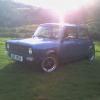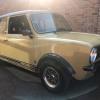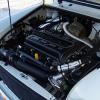
how dangerous are wheel spacers??
Started by
Clubby1275GT
, Dec 14 2005 11:32 AM
9 replies to this topic
#1

Posted 14 December 2005 - 11:32 AM
ive already got inch spacers on the back because revolutions dont seem to stick out much, although they are 7x13?? i think, well the measurements i get never seem to be right! they take 175/50/13 tyres.
any way, i put 'em on the back, changing the studs for longer ones, was wondering whether having them on the front, anout 3/4 inch would be dangerous in anyway??
Just dont want my wheel overtaking me on the motorway one day!
Cheers Guys
Daz
any way, i put 'em on the back, changing the studs for longer ones, was wondering whether having them on the front, anout 3/4 inch would be dangerous in anyway??
Just dont want my wheel overtaking me on the motorway one day!
Cheers Guys
Daz
#2

Posted 14 December 2005 - 12:39 PM
have you got discs on the front? if so then you shouldn't really need them! as for the rear, buy a set of minifins, they have the spacer built into them!
#3

Posted 14 December 2005 - 01:00 PM
i would only put 3 or 5 mm on the front max if i were you, personally i dont think its a good idea at all
#4

Posted 14 December 2005 - 01:03 PM
"How dangerous are wheel spacers?" How long is a piece of string? The answer is relative.
Long wheel studs imply that the wheel has been moved further and further outward away from the wheel bearings. This is bad for the bearings and means that the studs are under more stress. On the other hand, if you leave your car parked all the time... long wheel studs are fine.
Long wheel studs imply that the wheel has been moved further and further outward away from the wheel bearings. This is bad for the bearings and means that the studs are under more stress. On the other hand, if you leave your car parked all the time... long wheel studs are fine.
#5

Posted 14 December 2005 - 01:15 PM
There's no reaon wheel spacers should be dangerous given the right circumstances.
1. If you are using shims (i.e. just a "thin" plate put on the existing hub, and using the same hub-bolts to attach the wheel), then you MUST buy longer studs. The length increase needs to be the same as the thickness of the shim.
2. If you use sandwich spacers (i.e. spacers that you bolt to the hub using the existing studs, and then they have 4 new bolts from the spacer to attach the wheel), then you MAY NOT need to extend the existing studs (but you should check how many turns you needed to put on the standard wheel, and then match the number of turns needed to hold on the spacer). you should also check the same thing on the spacer studs. This way you are assured of having the correct interface between the stud and the bolt. Ensure also that you torque the nut holding the spacer to the hub to the same degree as you would the wheel. Remember also to periodically check the spacer nuts torque as you would a normal wheel nut torque. Personally, I always like to buy TUV approved (German MOT people) spacers. purely because they at least have been checked and tested to a degree of safety, more than £5.99 ones off ebay ever will! You will pay more, but hey, it's safety critical!
3. IMHO (and it is only my opinion), upto 9mm, you are probably safe running shims. over that and you'll need proper spacers. Even though you may have the required number of threads holding the wheel on, the increased bending forces by having the wheel further out on the stud will not do it a lot of good.
3. Spacing a wheel can be detremental to the wheel bearing. HOWEVER, it's not a given that adding a spacer will automatically do this. The hub is designed so that it takes a load offset from the bearing (imagine a vertical line from the centre of the hub, and another down the centre of the wheel). As long as this relationship is kept the same, then the bearing sees no extra load. the problem is, is that this is generally not the case. Think of it this way: imagine you're going from a standard 4.5" wide wheel to a 7". this means a 2.5" increase. now look at the arches. you'll go from a small 1" extension to a 3" extension. that would mean that the wheel would move out 2", with a 1/2" of the wheel increasing to the inside, and thus the centreline of the wheel would move out by 1.5", increasing the load on the bearing. What the safe limit on this is, is probably a matter for the more experienced mini men, and although this seems safe (as lots of people do it), It would certainly mean that a much more frequent check on the bearing, and a more frequent replacement should be made.
1. If you are using shims (i.e. just a "thin" plate put on the existing hub, and using the same hub-bolts to attach the wheel), then you MUST buy longer studs. The length increase needs to be the same as the thickness of the shim.
2. If you use sandwich spacers (i.e. spacers that you bolt to the hub using the existing studs, and then they have 4 new bolts from the spacer to attach the wheel), then you MAY NOT need to extend the existing studs (but you should check how many turns you needed to put on the standard wheel, and then match the number of turns needed to hold on the spacer). you should also check the same thing on the spacer studs. This way you are assured of having the correct interface between the stud and the bolt. Ensure also that you torque the nut holding the spacer to the hub to the same degree as you would the wheel. Remember also to periodically check the spacer nuts torque as you would a normal wheel nut torque. Personally, I always like to buy TUV approved (German MOT people) spacers. purely because they at least have been checked and tested to a degree of safety, more than £5.99 ones off ebay ever will! You will pay more, but hey, it's safety critical!
3. IMHO (and it is only my opinion), upto 9mm, you are probably safe running shims. over that and you'll need proper spacers. Even though you may have the required number of threads holding the wheel on, the increased bending forces by having the wheel further out on the stud will not do it a lot of good.
3. Spacing a wheel can be detremental to the wheel bearing. HOWEVER, it's not a given that adding a spacer will automatically do this. The hub is designed so that it takes a load offset from the bearing (imagine a vertical line from the centre of the hub, and another down the centre of the wheel). As long as this relationship is kept the same, then the bearing sees no extra load. the problem is, is that this is generally not the case. Think of it this way: imagine you're going from a standard 4.5" wide wheel to a 7". this means a 2.5" increase. now look at the arches. you'll go from a small 1" extension to a 3" extension. that would mean that the wheel would move out 2", with a 1/2" of the wheel increasing to the inside, and thus the centreline of the wheel would move out by 1.5", increasing the load on the bearing. What the safe limit on this is, is probably a matter for the more experienced mini men, and although this seems safe (as lots of people do it), It would certainly mean that a much more frequent check on the bearing, and a more frequent replacement should be made.
#6

Posted 14 December 2005 - 01:22 PM
ive got spaced drums on the back but they still dont fill the arches, ive got group 5's but revolutions dont seem to stick out much from the arches, defo need something on the front, yeah 8.4 discs on the front too. reckon i need about half inch more on the front, my mate has the same sized wheels but there minilite deep dishes and they fill the same size arches with no spacers, is it something to do with the pcd?
#7

Posted 14 December 2005 - 01:24 PM
no the PCD is the stud pattern (pitch circle diameter). Its probably to do with the offset of the wheels more than anything else.
#8

Posted 14 December 2005 - 02:10 PM
yeah thats it, the offset, but i cant be doing with small arches, gotta be wide!! can afford new wheels, plus i love revo's too much to change 'em!
#10

Posted 14 December 2005 - 07:06 PM
Spaced drums AND inch spacers :saywhat: Don't hit any big bumps fast and make sure the wheel nuts are gurt tight 
The maximum back space for the Mini is 100mm. That is the distance from the mounting face to the back edge of the rim, so if this dimention is bigger than 100mm then the wheels were not designed for the mini :erm:
Only other thing is are you sure they are deffinately 13x7's :fear: I'd recon they sound more like 13x6's if you are struggling to fill the arch, requireing inch spacers
Quarter inch shims on the front MAX and three quarter inch on the back is pushing it, though people do seem to say that it wont give any problems. I'd rather not for reasons of reliability and durebility.
Check this site as a good refference for wheel sizes including the back space and off set dimentions http://www.wellerwhe...Send_button.y=5
The maximum back space for the Mini is 100mm. That is the distance from the mounting face to the back edge of the rim, so if this dimention is bigger than 100mm then the wheels were not designed for the mini :erm:
Only other thing is are you sure they are deffinately 13x7's :fear: I'd recon they sound more like 13x6's if you are struggling to fill the arch, requireing inch spacers
Quarter inch shims on the front MAX and three quarter inch on the back is pushing it, though people do seem to say that it wont give any problems. I'd rather not for reasons of reliability and durebility.
Check this site as a good refference for wheel sizes including the back space and off set dimentions http://www.wellerwhe...Send_button.y=5
1 user(s) are reading this topic
0 members, 1 guests, 0 anonymous users




















